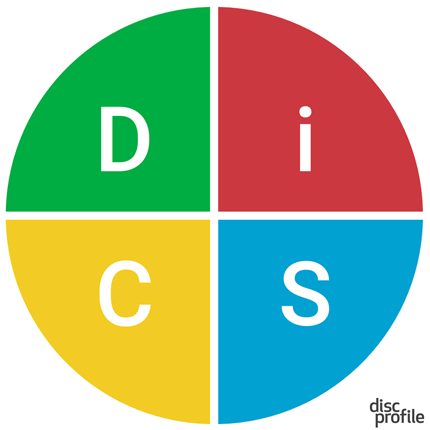One of the most crucial aspects of productivity is communication. Without it, mistakes are made, people are misinformed, and conflict arises.
Almost 75 percent of communications are misinterpreted or misconstrued, costing employers time and money.
Businesses that are struggling to break through to certain employees can utilize personality tests to increase their self-awareness and improve management in the workplace.
Though many believe themselves to be self-aware, or able to see one’s self objectively, a Harvard Business Review study found only 10 -15 percent actually are.
Talking with prospects and other sales team members, we saw room to improve communication in our internal sales department. There are many tests and assessments to choose from but we chose the DISC assessment.
Unlike the Enneagram or the Myers-Briggs Assessment, we felt DISC was simple, straightforward, and wasn’t too complicated for our team to understand.
What is the DISC Assessment?

The DISC assessment is a personality test that measures how one behaves. It’s a fantastic resource to learn how to work and communicate with a diverse team.
The DISC Assessment evaluates and categorizes a person’s traits into one of four different categories:
- Dominance
- Influence
- Steadiness
- Compliance
Dominance
Those in the Dominance category are stimulated by problems, and have a high drive to see results. While they can be seen as impatient and demanding at times, they are extremely driven and confident in their abilities to get the job done.
According to the test developers, the D styles are motivated by competition, winning, and success. They fear being seen as vulnerable or being taken advantage of, and can cause tension when they are too focused on their drive to achieve.
However, it isn’t from a place of negativity. Those that make up the Dominance category look for justice in conflict, and can improve by practicing empathy and patience. A healthy D can be one of the most influential people in your organization.
Notable examples in this category include Steve Jobs, Venus Williams, and Franklin D. Roosevelt
Influence
Individuals in the Influence category are stimulated by people. Famously known for being extroverted, influencers are very energetic and positive people. While they can come across as impulsive or inconsistent at times, they are known for being great salespeople.
The nightmare of an I is being ignored or rejected. They value freedom of expression, counseling and coaching. While they can be a little too optimistic, they use this positivity to influence others.
In conflicting situations, they aren’t the best at keeping secrets. An I that is objective and that follows through can transform your business in ways you didn’t know were possible.
Notable examples in this category include Bill Clinton, Eddie Murphy, and Carol Burnett.
Steadiness
People in the Steadiness category are motivated by processes. They are fantastic at providing support, being reliable, and are very patient and easygoing. Those that fall into this category are very uncomfortable with change and can be possessive at times, but they are great at building relationships.
They are extremely loyal and value security. While they can be too modest at times, they are great at hearing out other perspectives in conflict. With the majority of S’s make up the population, its a big possibility they make up the most of your company.
Work with them to display more self-confidence, revealing their true feelings.
Notable examples in this category include Mother Teresa, Stevie Wonder, and David Beckham.
Compliance
The Compliance category is typically made up of those who are stimulated by accuracy and precision. While they can be somewhat reserved and skeptical, they are quite often the most loyal and methodical individuals you will ever meet.
Those in the Compliance category hate being criticized. They tend to overanalyze, but their logical thinking skills are second to none. In conflicting situations, they can be overwhelming with facts that support their opinion.
By acknowledging others’ feelings and not relying on data, they can become easier to work with while still providing a wealth of insight.
Notable examples in this category include Albert Einstein, Bill Gates, and Warren Buffett.
Our Experience Using DISC

Our executive team and internal sales department spent a day taking the DISC assessment and discussing their results.
Nelson Batista, the Regional Sales Director who helped carry out the DISC Assessment, shares what they gained and how communication improved below:
Why was your management team interested in taking the personality test?
To find similarities in the successful people of this particular department, and to train our staff in recognizing how to communicate more efficiently with one another.
For example, we had our internal sales team take the test, and we looked for patterns in their work performance and their personality traits. This gave us valuable information on how everyone in the department perceives various words and actions differently from one another.
Was everybody open to the idea? Was there any pushback?
There was a lot of curiosity on where we would end up being categorized on the actual assessment.
It was communicated early on that we were trying to find similarities in different individuals; this wasn’t a judgment on their performance by any means, but we wanted to give our staff the opportunity to do some self reflection, and to use the findings to better their performance in the office, or when working with others.
How long did the testing process take?
The actual survey for the assessment took no more than 15 minutes for each person. We all did it in a closed session.
Shortly after, we got the results, and the heads of the department had a chance to review the results before presenting it the next morning. There were four particular categories, and each individual could see where they fit in those categories.
We proceeded to go over each one, explaining how each type communicates, what style of leadership they work best with, and some of the things that they can do to improve their performance.
Everything was presented in good faith and as an opportunity. A lot of people enjoyed it; we actually ended up talking as a department for almost 45 minutes afterwards just comparing results.
Did you feel that this made a difference in how everyone interacted with one another?
I think for the people who took it seriously, yes.
I say ‘seriously’ because you have to use a tool every day to find value in it. And I think it made me rethink how I approach other styles. For example, I would speak with employees several weeks after finding the results just to kind of say,
“Hey, this is what I’m doing to improve my communication with other people, this is how I’m able to work better with other personality types in the workplace , etc.”
Has communication improved since taking the DISC?
I’ve actually seen communication improve. Everybody is more conscious of how they respond to others, how they’re listening, and have a better understanding of how they can affect conversations in a beneficial way.
If I’m speaking to a group of 14 individuals for example, you can’t just say one thing one way because it’s completely unknown how everyone will react to that.
How can I make it clear without having to say it 14 different ways? And what are they going to take away from this conversation? In that regard, things have really improved, and as a department we have seen much more focus and collaboration.
For example, before the DISC test, we did 12 to 17 appointments a week. Now, we are pushing to 30 to 40 appointments a week, and the overall atmosphere is much more positive
If given a second chance, would you have your team take that risk assessment again? Would you invest in the same personality test?
I would definitely want to take this on again for two reasons:
- So that new hires can see where they fit into the four categories
- So those who previously tested can see the progress they’ve made
Our goal is to get closer to the center of all the categories, where you have an understanding of every communication style, and this would be a great way to track our progress. However, there are other tools available that I would be open to using.
What was the most common personality style for people in the department?
It was very interesting; leadership was mostly Dominant (D) with the exception of one on our management team, who was Supportive (S).
When you have someone who’s direct and you have someone who’s supportive, they complement each other very well, and can play off of each other’s strengths.
I think that’s why management and leadership get along so well with our staff. Management is supportive, very clear on direction, and reminds everyone of the bigger picture.
This works hand in hand with leadership, which is much more focused on making sure things are moving forward, and the mortars between the bricks, as you call it, are sitting properly.
Our DISC Assessment Results

After taking the assessment:
- Department productivity doubled per week
- Turnover rates have dropped over the past 6 months following the DISC test
- Employee morale has risen significantly within the department, and there is more camaraderie among the office.
How DISC Can Help Business Owners
By utilizing a personality test such as the DISC assessment, business owners and their employees are able to gain valuable insights into the individual behaviors, communication styles, and points of views of others around them.
Massive organizations such as Coca-Cola, American Express, General Electric, and Microsoft all use this personality tool to improve self awareness in their companies.
Understanding how others contribute to the success of the company allows everyone, from the CEO to the janitor, to be more effective team players in the business.
If you would like to know more about how the DISC personality assessment can help your business, fill out the contact below to talk with one of our department heads first-hand:
